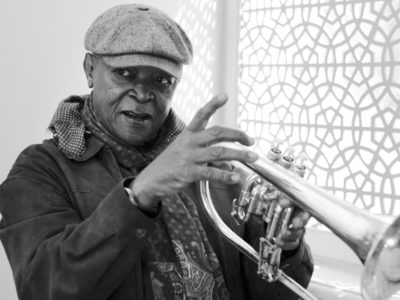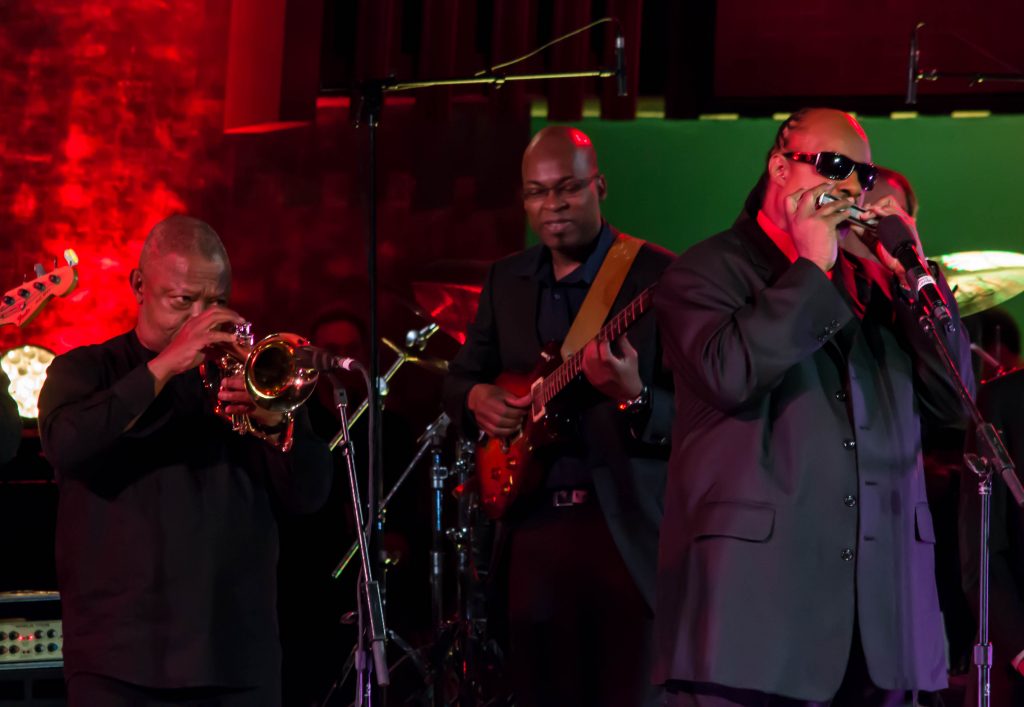
The South African jazz trumpeter Hugh Masekela first came to the attention of most American music fans in early 1967 when he guested on the Byrds’ hit single “So You Want to Be a Rock ’n’ Roll Star.” In June of that year he appeared at the Monterey Pop Festival—his appearance was captured for the documentary film Monterey Pop, in which he performs “Bajabula Bonke (The Healing Song).” Eric Burdon and the Animals name-checked him in their hit “Monterey”: “Hugh Masekela’s music was black as night.”
By that time, Masekela was already a major star in his homeland. Born Hugh Ramopolo Masekela in Kwa-Guqa Township, Witbank, South Africa, on April 4, 1939, he started out in music as a pianist before taking up the trumpet at 14. He and some schoolmates formed the Huddleston Jazz Band, South Africa’s first youth orchestra, and in 1956 Masekela joined Alfred Herbert’s African Jazz Revue. He also began composing in the late 1950s.

Following a successful run touring South Africa in the company of a musical version of King Kong (singer Miriam Makeba was also involved), Masekela and several other musicians (including Dollar Brand, later known as Abdullah Ibrahim) formed the Jazz Epistles and toured their country. As racial tensions in South Africa heated up due to the country’s ongoing apartheid policy, Masekela left his homeland and settled in London. He then came to the United States, where he attended the Manhattan School of Music, studying classical trumpet from 1960 to ’64. In that year he also married Makeba, although they divorced two years later.
Signed to the Uni label in the U.S., Masekela, who also played flugelhorn and cornet, and sang, scored his first charting album in this country with Hugh Masekela’s Latest in the summer of 1967, shortly after the Monterey appearance. His first charting single was an instrumental version of Jimmy Webb’s “Up, Up and Away,” but it was his instrumental version of “Grazing in the Grass,” written by Philemon Hou, that brought him to the very top of the Billboard singles chart in 1968. The single won a Grammy for Best Contemporary Pop Performance—Instrumental. (He would be nominated for Grammys seven times in all, winning twice.)
Listen to Masekela’s #1 hit “Grazing in the Grass”
[The Friends of Distinction recorded a vocal cover of the song, which reached #3 in 1969.]
Masekela placed three further singles on the American chart but none came close to repeating the success of the chart-topper. He also placed six more albums on the American chart through 1978, of which 1968’s The Promise of a Future scored the highest, reaching #17. He released more than 50 albums during his career, most recently 2016’s No Borders.
Related: What were some of the other great instrumental hits of the ’60s?
Masekela toured with Paul Simon on the latter’s Graceland tour and contributed flugelhorn to Simon’s “Further to Fly” on the latter’s 1990 album Rhythm of the Saints, but primarily Masekela—who became known as “the father of South African jazz”—remained within the jazz milieu for the remainder of his career. He was fond of experimenting with his music, incorporating techno, R&B, Brazilian music and other forms into his sound.
He was also a social activist and in 2003 was featured in he documentary film Amandla! A Revolution in Four-Part Harmony.
Related: In addition to Monterey Pop, Masekela also performed at the 1969 Atlantic City Pop Festival
Watch Hugh Masekela in the film Monterey Pop
Masekela died Jan. 23, 2018, in Johannesburg after what his family called a “protracted and courageous battle with prostate cancer.” He was 78.
His recordings are available in the U.S. here and in the U.K. here.
- Over Under Sideways Down: Making Sense of the Yardbirds’ Album Releases - 05/27/2024
- 17 Classic Chuck Berry Covers - 05/18/2024
- ‘Brandy’ by Looking Glass (It’s a Fine Song) - 05/18/2024


1 Comment
Masekela also recorded a “duet LP” with Herb Alpert in the late 70s. Which was impossibly rare until Herb re-released it on CD a few years ago. It was/is pretty good.